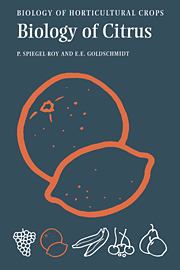Introduction
Published online by Cambridge University Press: 27 October 2009
Summary
The biology, history and development of citrus fruits have aroused worldwide interest. This has been enhanced, to a large degree, by the uniquely attractive appearance of the fruit and by its medicinal properties.
Citrus fruits originated in South East Asia and spread during the Middle Ages, later to become established in all continents. Citrus is by far the most important evergreen fruit crop in world trade. The fruit's special structure and long shelf life have facilitated its large-scale export as fresh fruit. Processed juice products, on the other hand, have also become increasingly important worldwide.
The exact origin of Citrus, its ancestral types and systematics are still largely unknown. The great wealth of citrus types and cultivars of today reflects the vast natural breeding options within Citrus, as well as effective intentional human intervention. Molecular genetics, which has been a most helpful tool in unraveling the secrets of the past, also opens new vistas for breeding work in the future. Modern citriculture has adopted parthenocarpy and seedlessness for all major citrus types. Present-day cultivars represent largely subtle gene combinations conserved by vegetative propagation on seed-propagated, apomictic rootstocks.
Classical citriculture achieved the highest fruit quality in subtropical areas. Low temperatures and frost hazards limit the expansion of citriculture into cooler domains. Citrus has always been known to be highly dependent on irrigation in most environments.
- Type
- Chapter
- Information
- The Biology of Citrus , pp. 1 - 3Publisher: Cambridge University PressPrint publication year: 1996
- 2
- Cited by



